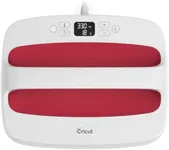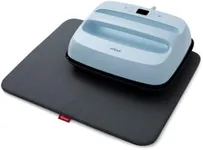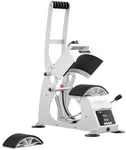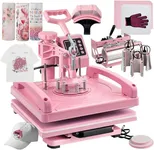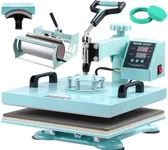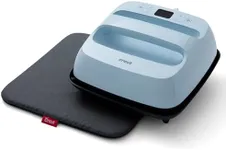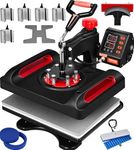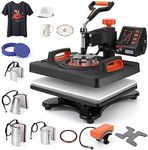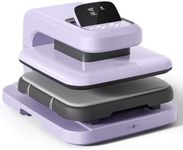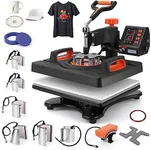Buying Guide for the Best Heat Press Sublimation Machine
Choosing the right heat press sublimation machine can be a game-changer for your crafting or business needs. These machines are used to transfer designs onto various materials, such as t-shirts, mugs, and other items, using heat and pressure. To make the best choice, you need to consider several key specifications that will determine the machine's suitability for your specific needs. Understanding these specs will help you navigate the options and select a machine that will deliver the results you want.Size of the Heat PressThe size of the heat press refers to the dimensions of the platen, which is the flat surface that applies heat and pressure to your material. This spec is important because it determines the maximum size of the items you can work with. Smaller machines, with platens around 9x12 inches, are suitable for small items like baby clothes or small patches. Medium-sized machines, with platens around 15x15 inches, are versatile and can handle most t-shirts and other medium-sized items. Larger machines, with platens 16x20 inches or bigger, are ideal for large garments, banners, and other sizable projects. Choose a size based on the typical dimensions of the items you plan to work with.
Temperature RangeThe temperature range of a heat press machine indicates the maximum and minimum temperatures it can reach. This is crucial because different materials and transfer types require different temperatures. A machine with a wider temperature range, typically from 0 to 450°F, offers more versatility and can handle a broader range of projects. If you plan to work with a variety of materials, such as fabrics, ceramics, and metals, opt for a machine with a higher maximum temperature. For standard t-shirt printing, a machine that reaches up to 400°F is usually sufficient.
Pressure AdjustmentPressure adjustment allows you to control the amount of force applied during the heat transfer process. This is important because different materials and transfer types require different pressure levels to achieve optimal results. Machines with manual pressure adjustment let you fine-tune the pressure by turning a knob or lever. Some advanced models offer automatic pressure adjustment, which can be more convenient and consistent. If you plan to work with a variety of materials, a machine with easy and precise pressure adjustment is beneficial. For beginners, manual adjustment is usually sufficient and provides good control.
Heat DistributionHeat distribution refers to how evenly the heat is spread across the platen. Even heat distribution is crucial for achieving consistent and high-quality transfers. Poor heat distribution can result in uneven transfers, with some areas being over or under-pressed. Look for machines that advertise even heat distribution, often achieved through high-quality heating elements and construction. If you plan to produce professional-grade items, investing in a machine with excellent heat distribution is essential. For casual or hobby use, a standard machine with good reviews on heat consistency should suffice.
Digital ControlsDigital controls on a heat press machine allow you to set and monitor the temperature and time precisely. This is important for achieving consistent results, as different materials and transfer types require specific settings. Machines with digital controls typically feature an LCD screen and buttons for easy adjustments. Advanced models may offer programmable settings for different projects. If you value precision and ease of use, opt for a machine with digital controls. For those who prefer simplicity, basic models with analog controls can still be effective but may require more manual monitoring.
Type of Heat PressThere are several types of heat press machines, including clamshell, swing-away, and draw. Clamshell presses open and close like a clamshell, making them compact and easy to use, ideal for beginners and small spaces. Swing-away presses have an upper platen that swings away from the lower platen, providing better access to the work area and reducing the risk of burns, suitable for more complex projects. Draw presses have a lower platen that pulls out like a drawer, offering easy access and precise placement of materials. Choose the type based on your workspace, safety preferences, and the complexity of your projects.
